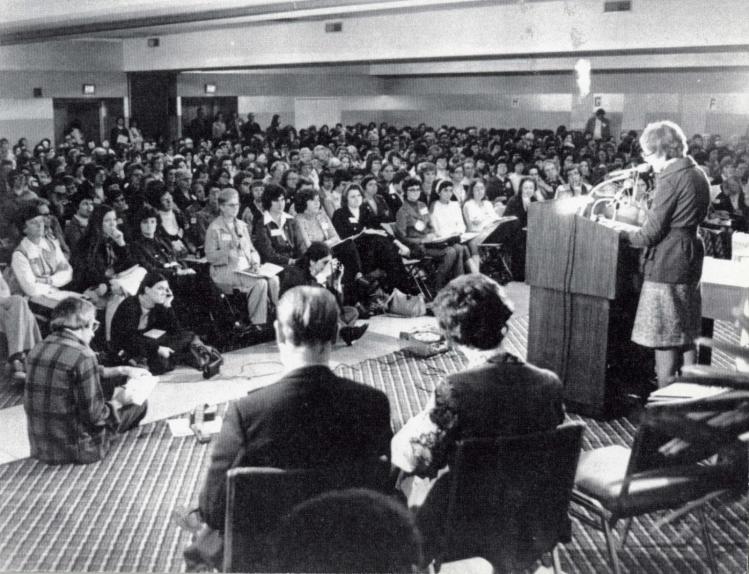
Interested in discussing this article in your classroom, parish, reading group, or Commonweal Local Community? Click here for a free discussion guide.
On Thanksgiving in 1975, my aunt Anne stopped by our home in Ft. Wayne, Indiana, on her way to a conference in Detroit. I was intrigued about the event she helped organize, which focused on women and Catholic priesthood. As a seven-year-old girl preparing for First Communion, I had wanted to become an altar server and ring those little bells someday, but the role was limited to boys. In International Women’s Year, there was reason to be hopeful.
That first Women’s Ordination Conference in Detroit was attended by two thousand people and helped shape the conversation on inclusive priesthood for decades to come. Altar serving opened to girls about ten years later. Changes were afoot, but embarrassingly slow in my view, so as a young adult I drifted from Church involvement.
But my aunt, Anne E. Patrick, SNJM, theologian, author, and religion and women’s studies professor at Carleton College, kept up a gentle nudging. She recognized my desire to nurture a close relationship with the divine and to share God’s love with others. She supported and counseled me as I raised my children in the Church. She encouraged me to accept a job at Georgetown University, and later wrote my recommendation for grad school.
By her lived example of sticking by the Church—in the Church—while trying to reform it, she showed our family a way to respond creatively to injustice. Her life is what I have come to understand as the kind of life Jesus himself led. He didn’t abandon the imperfectly practiced tradition of his family, but offered guidance on how to put love at the center of how we treat one another, even when it means breaking unjust rules.
I learned more about the 1975 conference only recently. Participants traveled from forty-five states and overseas to explore the possibilities for a renewed, inclusive priesthood. Renowned theologians including Margaret Farley, RSM, Anne Carr, BVM, and Elisabeth Schüssler Fiorenza presented at the conference. Attendees and public endorsements came from most major orders, many theologians, and other university faculty and Catholic leaders. In other words, this conversation was happening in the mainstream. But this open, visionary dialogue was silenced by the Vatican in the years to come, and today, most Catholics have never even heard of the assembly.
Why does this matter so much? For me, the exclusion of women from ordination is the most important issue facing the Church today because it results in so much pain. It’s an age-old system of supremacy that needs radical removal—taking it out by its roots, literally. Until women are at the table in large numbers, the Church can’t begin to fully hear the cries of the poor, the young, the disabled, the abused, and the marginalized whom the Church claims to prioritize. As creators who have the potential to give birth, women are agents of the sacred, with unique experiences and perspectives that must be shared in order to know a fuller picture of the divine. We, too, reveal God’s image.
At sacred assemblies at Georgetown, I’ve witnessed women chaplains of other faiths singing and praying and preaching, and every time I felt a pang of sadness that the Catholic Church is missing out on this. We are depriving ourselves of the divine as embodied by women. How much more fully would we express the sacraments if women were administering them, too?
In April 2023, hundreds gathered in person and online from around the world to tune in for “Faith, Feminism, and Being Unfinished,” which I co-organized. Angele White, a health minister and founder of the Black & Women’s History Ministry at St. Martin of Tours parish in Washington D.C., spoke of the history of discrimination against Catholics since the founding of this country. “Change takes time,” she noted. “And it takes determination, strategy, risks, patience, compassion, and passion.” If people didn’t stick with imperfect institutions, they would never be transformed. “There would probably be no women in positions of power to make meaningful changes, with the exception of ladylike, wifely, or motherly duties designated by men. And there would be no Black Catholics in the Church!”
Last October, I traveled to Rome to join the activities surrounding the Synod. These included a global lay-led synodal assembly with the group Spirit Unbounded, which is dedicated to human rights in the emerging Catholic Church. Speakers offered more than a hundred powerful testimonies from forty organizations working on Church reform. In her presentation, Ally Kateusz described a fourth-century ivory box which clearly depicts a man and woman concelebrating the Eucharist at the altar in Old St. Peter’s Basilica in Rome. This is one of the oldest images of early Christian liturgy. The significant location is identifiable by the unique spiral columns given by Constantine and represented today in Bernini’s altar, with the original buried below.
On my final day in Rome, I went inside St. Peter’s for the first time in twenty years. I was surprised how moved I felt, and my heart was drawn to the stunning baldacchino. No service was going on, so I walked up close and soaked it in, then took a selfie with it behind me, with a combination of smirk and prayer: “How long must women wait to be on this altar, O God?” I sighed and wandered away. A few minutes later, I looked back: lo and behold, a woman stood on that altar. An elderly sister in her habit, she held a spray bottle and rag and was wiping down the table. I shook my head and chuckled—God has a wicked sense of humor! And then I realized, God’s not joking.
Women have been at this altar all along, God was saying. You are my daughters, my queens, my caretakers, my coworkers, my companions. Soon women will be fully restored to our God-given leadership roles in places of worship, including this one, with all the challenges and blessings that will bring.
Not long after I returned home, the Vatican’s synthesis document was released. It described the working questions, reflections, and findings for this closing year of the Synod on Synodality. I noted the first two words in Italian and refer to it that way. Care sorelle (“Dear sisters”) offers some useful thoughts, but continues to fall short where women are concerned. Until we are welcomed by the Church fully into every role that God calls us to—including bishops, deacons, priests, and pope—this “hot-button issue” of inclusive ordination should not only be on the table but at the altar. It is indeed sacred to polish the chalice and ring the bells. But, assembly of women, shall we consider sharing all our gifts again in the co-responsibility of Christ?
This article is part of a symposium on women and the priesthood. Read the other articles here:
“Distorting the Gospel” – Teresa Delgado
“Moving the Center” – Mary E. Hunt
“Why Not Women?” – Alice McDermott
Please email comments to [email protected] and join the conversation on our Facebook page.
Previous Story
Regulating AI
Next Story
Hope or Consolation?


